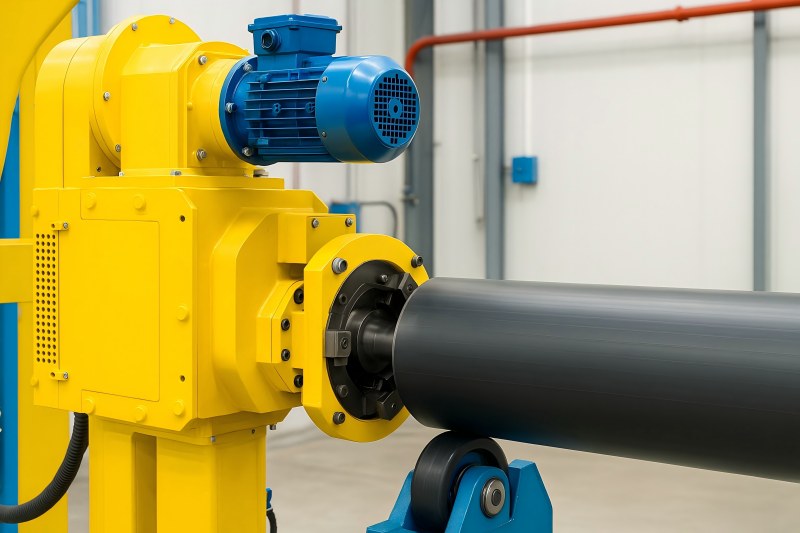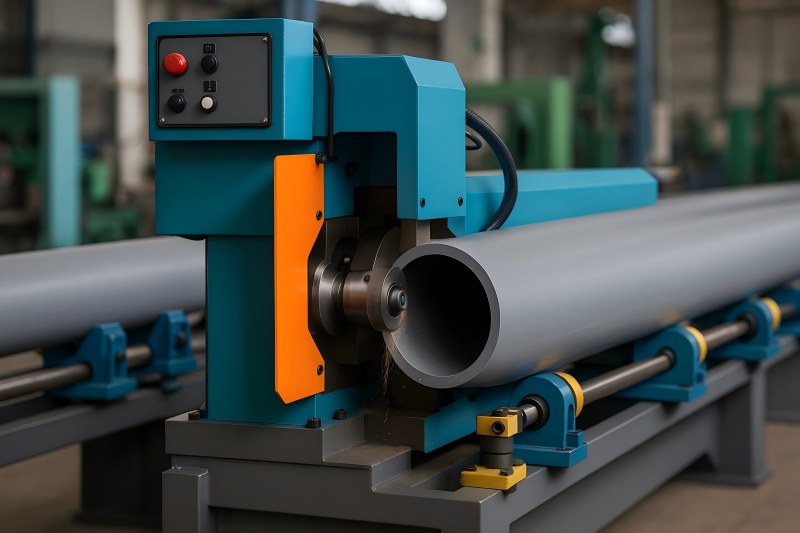Selecting the right plastic pipe chamfering machine is a crucial decision for any pipe production line. A proper match ensures smooth downstream operations, consistent joint quality, and reduced manual finishing. With many options available—manual, semi-automatic, inline, offline, single-head, multi-head—the process can feel overwhelming. This guide breaks down the key factors you should evaluate to make the right choice for your production line.
Role of Chamfering in Pipe Production
Chamfering is the process of beveling or shaping the edge of the pipe end, usually at a 15° to 45° angle, to ensure easier insertion into fittings and to prevent gasket damage. It is typically performed after cutting and before socketing or packaging.
A properly chamfered pipe end:
- Improves joint tightness by allowing proper gasket seating
- Reduces the risk of leakage in pressurized pipelines
- Facilitates easy installation on site
- Complies with international standards for pipe end finishing
Whether producing PVC, PE, or PP pipes, a reliable chamfering machine enhances both production efficiency and product quality.

Factors to Consider When Choosing a Chamfering Machine
Choose equipment that fits production speed, pipe sizes, layout, and automation needs effectively.
Pipe Diameter Range
Each machine model has a specific pipe size range it can handle. Choosing a machine that covers your main product sizes ensures flexibility and avoids frequent changeovers.
| Pipe Diameter Range | Machine Type Recommendation |
| 16–110 mm | Single-head automatic chamfering machine |
| 110–315 mm | Multi-head or inline chamfering system |
| 315 mm and above | Heavy-duty, offline chamfering station |
If your product range includes both small and large diameters, it may be more efficient to install two dedicated machines than to rely on one oversized unit with complex adjustments.
Production Speed and Line Integration
Chamfering machines can operate inline (connected directly to the extrusion line) or offline (standalone). Inline systems are ideal for high-speed continuous production, while offline systems are better for flexibility and smaller batches.
- Inline Chamfering: Installed after the cutting unit; operates synchronously with extrusion speed.
- Offline Chamfering: Pipes are transported to a separate machine; suitable for custom orders or mixed-diameter production.
| Production Speed | Recommended Chamfering Setup |
| Low (< 2 m/min) | Manual or semi-automatic offline |
| Medium (2–10 m/min) | Automatic single-head inline |
| High (> 10 m/min) | Multi-head high-speed inline system |
For modern factories, inline systems reduce handling costs, improve cycle time, and ensure every pipe is chamfered immediately after cutting—without piling up unfinished products.
Automation Level
Chamfering machines come in various levels of automation:
- Manual: Operator manually rotates pipes; affordable but inconsistent and labor-intensive.
- Semi-Automatic: Some positioning is automated but still needs manual help.
- Fully Automatic: Integrated feeding, positioning, chamfering, and ejection; ideal for high-output lines.
A fully automatic inline system can eliminate operator dependency, leading to consistent quality and reduced labor costs.
Chamfer Quality and Standards
Different projects or export destinations may require specific chamfer angles and lengths. The machine should:
- Produce clean, burr-free edges
- Allow angle and depth adjustment
- Ensure repeatability across large batches
Machines with digital or mechanical adjustment systems make it easier to meet diverse requirements, especially when switching between pipe sizes frequently.
Ease of Changeover and Maintenance
For factories producing various diameters daily, quick tooling change is essential. Look for:
- Modular clamping systems
- Quick-change chamfering heads
- Easy access for cleaning and blade replacement
Additionally, check the availability of spare parts, blade materials, and local technical support. Downtime due to maintenance delays can affect the entire production schedule.
Power Consumption and Energy Efficiency
Chamfering machines are often overlooked in energy optimization, yet they run continuously in high-speed lines. Selecting energy-efficient motors, optimized spindle speeds, and standby modes can lower operating costs.
Modern machines may include:
- Servo-driven chamfering heads
- Energy-saving frequency converters
- Automatic stop when no pipe is fed
These features contribute to both lower power bills and longer equipment life.
Budget and ROI Considerations
Your investment should align with your production scale, not just initial cost. Manual machines may be cheaper upfront but costly in terms of labor and inconsistent quality. Automatic systems have a higher price tag but deliver faster payback through:
- Increased output
- Lower manpower
- Consistent quality reducing rework
- Better integration with automation lines
When calculating ROI, include energy savings, labor cost reduction, and throughput improvements, not only machine price.
Matching Machine Type to Your Production Line
Here’s a simplified guideline to help you match the right machine type with your operation scale:
| Production Scenario | Recommended Machine | Key Benefits |
| Small workshop, occasional production | Manual or semi-automatic offline | Low cost, flexible |
| Medium-sized plant, standard production | Automatic single-head inline | Balanced cost and speed |
| Large-scale continuous production | Multi-head high-speed inline | High output, minimal labor, consistent chamfering |
| Mixed-diameter production with frequent changeovers | Flexible offline system with quick-change tooling | Easy adjustments, versatile use |
This approach ensures that your chamfering process supports your overall production strategy, rather than becoming a bottleneck.
Safety and Compliance
Safety should never be an afterthought. Look for machines with:
- Protective covers and emergency stop buttons
- Sensors to prevent operation when the pipe is misaligned
- CE or equivalent safety certifications
These features safeguard operators and equipment, minimizing accidents and downtime.
Vendor Reputation and After-Sales Support
Choosing a reliable manufacturer or supplier is just as important as choosing the right model. Consider:
- Experience in the plastic pipe machinery sector
- Local service technicians’ availability
- Spare parts lead time
- Installation and training assistance provided
A supplier with strong technical capabilities can tailor machine configurations to your specific line layout, helping you achieve optimal integration and performance.
Future-Proofing Your Investment
The plastic pipe industry is shifting toward fully automated smart factories, where machines are connected through PLC and SCADA systems for real-time monitoring. If your facility plans to upgrade in the coming years, select a chamfering machine that supports:
- PLC/automation integration
- Remote monitoring and diagnostics
- Flexible upgrades for additional heads or new pipe sizes
- Future-proofing keeps your investment relevant as technology evolves.
Selecting the ideal plastic pipe chamfering machine boosts efficiency, quality, and profitability. By evaluating factors such as pipe diameter range, production speed, automation level, chamfer quality, maintenance requirements, energy use, and vendor support, you can make a well-informed choice that aligns with your operational goals.
For high-volume extrusion lines, fully automatic inline chamfering systems offer the best long-term returns. Always balance initial investment against throughput, labor savings, and quality gains to maximize ROI.

